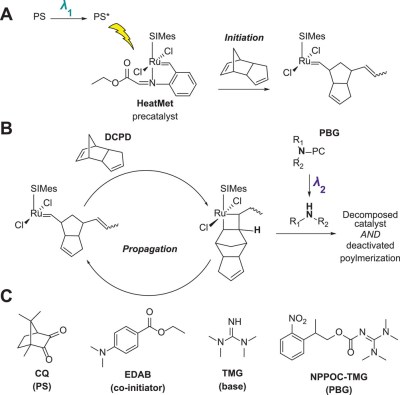As widespread as 3D printing with stereolithography (SLA) is in the consumer market, these additive manufacturing (AM) machines are limited to a single UV light source and the polymerization of free-radical polymerization (FRP) resins. The effect is that the object is printed in layers, with each layer adhering not only to the previous layer, but also the transparent (FEP or similar) film at the bottom of the resin vat. The resulting peeling of the layer from the film both necessitates a pause in the printing process, but also puts significant stress on the part being printed. Over the years a few solutions have been developed, with Sandia National Laboratories’ SWOMP technology (PR version) being among the latest.
Unlike the more common FRP-based SLA resins, SWOMP (Selective Dual-Wavelength Olefin Metathesis 3D-Printing) uses ring-opening metathesis polymerization (ROMP), which itself has been commercialized since the 1970s, but was not previously used with photopolymerization in this fashion. For the monomer dicyclopentadiene (DCPD) was chosen, with HeatMet (HM) as the photo-active olefin metathesis catalyst. This enables the UV-sensitivity, with an added photobase generator (PBG) which can be used to selectively deactivate polymerization.

The advantage of DCPD is that this material and the resulting objects are significantly robust and are commonly thermally post-cured (250 °C for 30 seconds for the dogbones in this experiment) to gain their full mechanical properties. Meanwhile the same dual-wavelength setup is used for continuous SLA printing as previously covered by e.g. [Martin P. de Beers] and colleagues in a 2019 paper in Science Advances. Not only does the photoinhibitor with FRP and ROMP resins prevent the attachment of polymerized resin onto the transparent film or window, due to the localized control of the photoinhibitation depth dual-wavelength SLA is not limited to single layers, but can print entire topological features in a single pass.
This method might therefore be better than both existing FRP-based mono-wavelength SLA, and the proprietary CLIP technology by Carbon with its oxygen-permeable membrane, with no peeling and with print speeds of many times that of conventional SLA. Currently Sandia is looking for partners to develop and commercialize this technology, raising the hope that such dual-wavelength SLA printers may make it onto the market by manufacturers which do not require a security clearance and/or proof of financial liquidity before you even get to talk to a salesperson.

Zita boo
Interesting